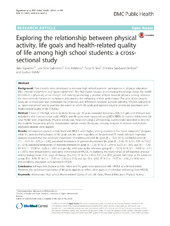| dc.contributor.author | Sigvartsen, Julie Ann | en_US |
| dc.contributor.author | Gabrielsen, Leiv Einar | en_US |
| dc.contributor.author | Abildsnes, Eirik | en_US |
| dc.contributor.author | Stea, Tonje Holte | en_US |
| dc.contributor.author | Omfjord, Christina Sandvand | en_US |
| dc.contributor.author | Rohde, Gudrun-Elin | en_US |
| dc.date.accessioned | 2017-08-01T13:48:40Z | |
| dc.date.available | 2017-08-01T13:48:40Z | |
| dc.date.issued | 2016-08-03 | |
| dc.Published | Sigvartsen, Gabrielsen LE, Abildsnes E, Stea T, Omfjord CS, Rohde G. Exploring the relationship between physical activity, life goals and health-related quality of life among high school students: a cross-sectional study. BMC Public Health. 2016;16:709 | eng |
| dc.identifier.issn | 1471-2458 | |
| dc.identifier.uri | https://hdl.handle.net/1956/16169 | |
| dc.description.abstract | Background: Two models were developed to increase high school students’ participation in physical education (PE): “motion enjoyment” and “sport enjoyment”. The first model focuses on increasing knowledge about the health benefits of a physically active lifestyle and thereby promoting a positive attitude towards physical activity, whereas the second model focuses on techniques and practices for enhancing athletic performance. The aims of the present study are to investigate and understand the similarities and differences between students selecting “motion enjoyment” vs. “sport enjoyment” and to examine the extent to which life goals and reported physical activity are associated with health-related quality of life (HRQOL). Method: A total of 156 high school students (mean age, 16 years [standard deviation = 0.8], 123 girls and 33 boys) were included in this cross-sectional study. HRQOL and life goals were measured using KIDSCREEN-10 and the Adolescent Life Goal Profile Scale, respectively. Physical activity was measured using a self-reporting questionnaire intended to describe the students’ leisure-time activity. Independent sample t-tests, chi-square, one-way analyses of variance and multiple regression analysis were applied. Results: Self-reported physical activity level and HRQOL were higher among students in the “sport enjoyment” program, while the perceived importance of life goals was the same regardless of the preferred PE model. Multiple regression analyses revealed that the perceived importance of relations-oriented life goals (B = −5.61; 95 % confidence interval CI = −10.53 to −0.70; p = .026), perceived importance of generativity-oriented life goals (B = 4.14.; 95 % CI = 0.85 to 7.422; p = .014), perceived attainability of relations-oriented life goals (B = 7.28; 95 % CI = 2.49 to 12.07; p = .003), age (B = −7.29; 95 % CI = −11.38 to −3.20; p = .001) and gender, with boys as the reference group (B = −12.10; 95 % CI = −19.09 to −5.11; p = .001), were independently associated with increased HRQOL. In exploring the relationships of self-reported physical activity during leisure time, stage of change (B = 3.53; 95 % CI = 1.49 to 5.51; p = .001), gender, with boys as the reference group (B = −8.90; 95 % CI = −15.80 to −2.00; p = .012), and age (B = −6.62; 95 % CI = −10.57 to −2.66; p = .001) were independently associated with increased HRQOL. Conclusion: Self-reported physical activity habits and life goals were associated with HRQOL to a limited extent. However, the perceived importance of life goals appears to reflect other aspects of individual well-being than HRQOL. | en_US |
| dc.language.iso | eng | eng |
| dc.publisher | BioMed Central | eng |
| dc.rights | Attribution CC BY | eng |
| dc.rights.uri | http://creativecommons.org/licenses/by/4.0 | eng |
| dc.subject | Adolescents | eng |
| dc.subject | High school | eng |
| dc.subject | Health-related quality of life | eng |
| dc.subject | Life Goals | eng |
| dc.subject | Physical Education | eng |
| dc.subject | Physical Activity | eng |
| dc.title | Exploring the relationship between physical activity, life goals and health-related quality of life among high school students: a cross-sectional study | en_US |
| dc.type | Peer reviewed | |
| dc.type | Journal article | |
| dc.date.updated | 2017-04-25T12:38:00Z | |
| dc.description.version | publishedVersion | en_US |
| dc.rights.holder | Copyright 2016 The Author(s) | |
| dc.identifier.doi | https://doi.org/10.1186/s12889-016-3407-0 | |
| dc.identifier.cristin | 1376031 | |
| dc.source.journal | BMC Public Health | |

